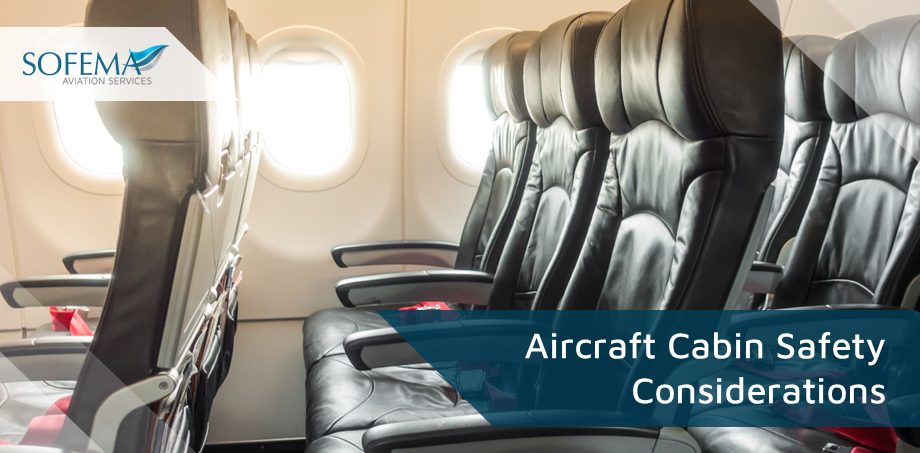Sofema Aviation Services (SAS) www.sassofia.com considers Aircraft Cabin Safety
ICAO Reference Standards for Cabin Safety (ICAO Annexes contain Standards and Recommended Practices (SARPs).
- Annex 6 — Operation of Aircraft, Part I — International Commercial Air Transport — Aeroplanes presents Standards and Recommended Practices related to:
o The operator’s in-flight procedures
o Passenger safety
o Carry-on baggage
o The minimum number of cabin crew required for each type of aeroplane
o The assignment of cabin crew members’ emergency duties
o Cabin crew at emergency evacuation stations
o The protection of cabin crew during flight
o Cabin crew training programmes
o Equipment required on board aeroplanes
o Cabin crew members’ fatigue management
o Security-related procedures and security training programmes (for the prevention of illicit acts against civil aviation)
- Annex 8 — Airworthiness of Aircraft presents Standards and Recommended Practices related to:
o Design and manufacturing of the aircraft cabin and the protection of its occupants
o Systems design features
o The operating environment and human factors, including ergonomics
o Crashworthiness and cabin safety, including:
- Design emergency landing loads
- Cabin fire protection
- Evacuation
- Lighting and marking
- Survival equipment
- Security-related design aspects of the cabin
Guidance material on airworthiness, including certification and surveillance can be found in the following documents:
- Airworthiness Manual (Doc 9760)
- Manual of Procedures for Operations Inspection
- Certification and Continued Surveillance (Doc 8335).
Cabin Safety Issues In General
- Passenger and cabin crew seating – Pitch, width, density
- Emergency exits, slides, evacuations
- Lavatory compartments
- Flammability standards and heat release
- Floor proximity lighting systems
- Overhead bins and cabin baggage
- Operational considerations
Note Concerning Seat Pitch: Both FAA & EASA advise it is a commercial decision
Note Concerning Fireworthiness: Whilst Toxic & flammable materials were a serious threat to survival (1970 – 1990) Cabin Baggage is currently one of the biggest threats today.
Cabin Flammability
Which Regulations Apply – At the very core of flammability compliance for aircraft interiors is regulation Section 25.853 and part 25, appendix F, part I, which details the test criteria.
Section 25.855 is also relevant to interior manufacturers who make products specifically for the cargo compartments of the aircraft.
Appendix F, part I, provides exact methods for the preparation of test samples, the configuration of the tests by product type, and the test result tolerances by product type.
The FAA Aircraft Materials Fire Test Handbook provides essential information on the various test methods and provides the appropriate test forms to be completed for each of the types of flammability tests.
- Today’s testing is based on the FAR/CS 25, the FAA Fire Testing Handbook and several Advisory Circulars
- 25.853 Part I Test Criteria and Procedures for Showing Compliance with Sec. 25.853,or 25.855.
- 25.853 Part II Flammability of Seat Cushions
- 25.855 Part III Test Method to Determine Flame Penetration Resistance of Cargo
- Compartment Liners.
- 25.853 Part IV Test Method to Determine the Heat Release Rate From Cabin Materials
- Exposed to Radiant Heat.
- 25.853 Part V Test Method to Determine the Smoke Emission Characteristics of Cabin
- Materials
- 25.856 Part VI Test Method To Determine the Flammability and Flame Propagation
- Characteristics of Thermal/Acoustic Insulation Materials
- 25.856 Part VII Test Method To Determine the Burn through Resistance of
- Thermal/Acoustic Insulation Materials
Electrical System Safety
Typical Issues to be considered:
- Integration and modification of electrical systems and avionics in the aircraft
o Flight Deck Avionics
o Cabin electrical systems
o IFE- systems
o Communication & Navigation Systems
- System Architecture – Development & Documentation (ICAW)
- Develop Substantiation data to show compliance with CS-25)
o System safety assessments,
o Electrical loads analyses and
o Equipment qualification
- Development of flight and ground tests Procedures
Airworthiness
Aircraft Certification Requirements:
- Derived from ICAO Annex 8 Airworthiness of Aircraft and the ICAO Airworthiness Manual, Part V State of Design and State of Manufacture.
o Each ICAO contracting state then establishes its own legal framework to implement the internationally agreed standards and recommended practices. The EU of course is represented by EASA
- EU: Procedures for certification of aeronautical products (aircraft, engines and propellers) – These are contained in EC Regulation 748/2012 Annex I – Part 2.
- USA: They are within FAR Part 21.
- These “Part 21” regulations also include procedures for the approval of design organisations (Sub-part J) and production organisations (Sub-part G). These processes are known respectively as Design Organisation Approval (DOA) and Production Organisation Approval (POA).
- Such approvals are a necessary pre-requisite to obtaining product certification.
Next Steps
Follow this link to our Library to find & Download related documents for Free.
Sofema Aviation Services (SAS) and Sofema Online (SOL) provide EASA Regulatory Compliant and Vocational training including more than 20 courses specifically related to Part 21 / CS 25.
For details please see www.sassofia.com & www.sofemaonline.com or email team@sassofia.com
Tags:
Aircraft, Aircraft Cabin Safety, aircraft design, Airport Security, Airworthiness, Airworthiness Manual, Aviation Regulations, aviation safety, Cabin Crew, Cabin safety, Certification, CS 25, Electrical System, FAA, Flammability, Flight, Flight Deck, ICAO, in-flight procedures, Part 21, Passenger safety, SAS blogs, Standards and Recommended Practices (SARPs), Standards for Cabin Safety




